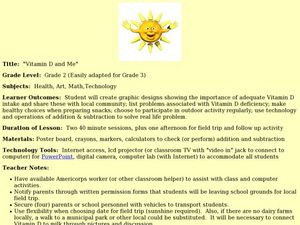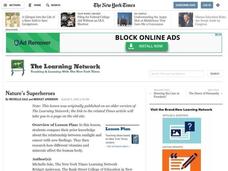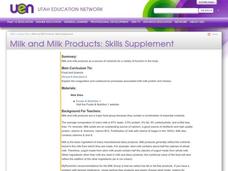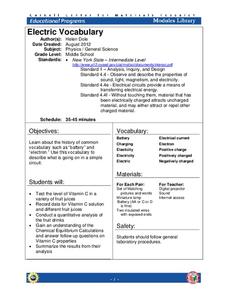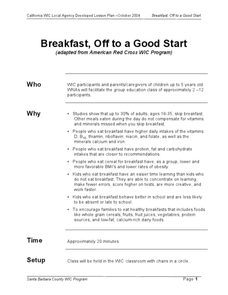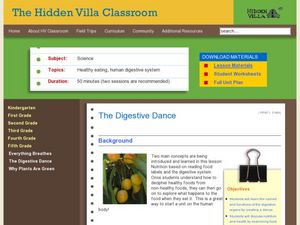Curated OER
Vitamin D and Me
Students create a graphic organizer showing the importance of Vitamin D intake. In this Vitamin D instructional activity, Students list problems with Vitamin D deficiency and create poster boards in small groups. Individually, students...
Curated OER
When Something's Missing: Diagnosing Vitamin Deficiencies
The New York Times "Education" section posts an extensive lesson on vitamin and mineral deficiencies. It involves class discussion, examination of food packaging labels, and the reading of a blog post about Vitamin D. The highlight of...
Howard Hughes Medical Institute
Human Skin Color: Evidence for Selection
Skin color is controlled by at least six genes. Young scientists learn about skin colors through a documentary. They discuss the topics of pigment, natural selection, and vitamin D absorption. They apply their knowledge to higher order...
Nuffield Foundation
Measuring the Vitamin C Content of Foods and Fruit Juices
Are you getting enough vitamin C? Young scientists determine the amount of vitamin C in fruit juice samples. They accomplish this task by adding DCPIP solution to the samples until the blue color of the DCPIP persists. Once this happens,...
Curated OER
Vitamin C and Protein Analysis
Students analyze various beverages to determine vitamin C content. Students research diseases resulting from vitamin C deficiencies and identify countries most affected.
Curated OER
Vitamins and Minerals
For this vitamins and minerals worksheet, pupils review how these are measured and determine what minerals the body needs. Students determine how different vitamins help the body to function properly. This worksheet has 22 short answer...
Curated OER
Vital Vitamins
Young scholars study vitamins and who should take them and what ones to take. For this investigative lesson students plan a healthy diet after reviewing the types of supplements.
Curated OER
Coming Soon: Sodas with Vitamins
Students react to a series of statements about sodas, then read a news article about the addition of vitamins to sodas to increase sales. In this nutrition and current events instructional activity, the teacher introduces the article...
Curated OER
Vitamin Planet
Students explain the function of vitamins in their body. In this health lesson, students identify the six types of vitamins. They create a chart comparing two of them.
Curated OER
Health In Progress - Processed Foods
Pupils compare and contrast processed foods to unprocessed foods. After exploring the differences, they research the health factors, benefits and concerns in both types of food. Discussions include fats, sweeteners, fiber, vitamins,...
Curated OER
Nature's Superheroes
Learners compare their prior knowledge about the relationship between sunlight and cancer with new findings. They research how different vitamins and minerals affect the human body.
Curated OER
Mystery "F & V's"
Fourth graders explore agriculture by reading assigned text about produce. In this fruits and vegetables lesson, 4th graders identify the healthy benefits of consuming fresh produce and what minerals and vitamins they contain. Students...
Curated OER
Nutrition
Students learn about good nutrition. In this biology lesson plan, students test samples of food to find out if they contain fat, test fruit juices for vitamin C and compare the vitamin C content of the juices, calculate the number of...
Curated OER
Nutrition Awareness
High schoolers gain an awareness of nutrition. In this science lesson plan, students explore how to determine his or her ideal body weight, demonstrate familiarity with the food groups relating to kilocaloric content, estimate the basic...
Curated OER
Milk and Milk Products: Skills Supplement
Explain the coagulation and coalescence processes associated with milk protein and cheese. List the components of milk and explain how each component is dispersed in the milk. Describe what happens when milk protein is coagulated Discuss...
Curated OER
Does Your Diet Stack Up?
Students investigate the food pyramid. In this nutrition lesson, students review the food pyramid and construct a list of what they eat. Students review the nutritional value of their food list and brainstorm ways to improve their diet.
Curated OER
Consuming Healthy Snacks
Get your class into great shape by introducing them to the benefits of eating healthy snacks and engaing in regular exercise. This set of activities comes with all the worksheets and handouts needed to complete several weeks of nutrition...
Cornell University
Electric Vocabulary
Practice electric vocabulary using multiple methods. Learners begin by watching a video that explains vocabulary related to electric currents. They match vocabulary cards to practice and then create an electric circuit. Using the...
Curated OER
Expressing a Condition with "If"
Before presenting the material to your classes, review different constructions of the conditional tense. This teacher's guide provides several examples and role-play opportunities with your class. Dialogue to build familiarity with the...
Arizona Board of Regents
The Pyramid of Power
Students explore the food pyramid, nutrition, and how to plan a balanced diet. This fun lesson is well-planned and a great introduction to the food pyramid!
Curated OER
Breakfast, Off to a Good Start
Students discover the benefits of eating a healthy breakfast. In this adult health lesson, students compare the characteristics of breakfast eaters and nonbreakfast eaters. They examine cereals for their fiber and sugar content.
Curated OER
Breakfast Boosts Brainpower
Young scholars examine the importance of eating a balanced breakfast. In this healthy eating lesson students identify examples of a healthy breakfast and compare the characteristics of people who do or do not eat breakfast.
Curated OER
UV Rays
Fourth graders study the effects of UV rays and practice finding the UV index for where they live. In this health instructional activity, 4th graders listen to a lecture about ultraviolet rays, then find the UV index in their area and...
Curated OER
The Digestive Dance
Young scholars read food labels to compare healthy verses non healthy food and then use diagrams to create a poster of the digestive system. In this food lesson plan, students move the food down the digestive track along the digestive...
